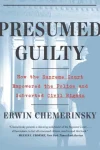Presumed Guilty: How the Supreme Court Empowered the Police and Subverted Civil Rights
 Author: Erwin Chemerinsky
Author: Erwin Chemerinsky
Publisher: Liveright, 2022. 384 pages.
Reviewer: Michael J. Zydney Mannheimer | March 2023
I first became interested in civil liberties as a teenager. My very first publication came at the age of sixteen in the form of a letter to the local newspaper decrying the Supreme Court’s then-recent decision in New Jersey v. T.L.O. (1985), which permitted searches of public-school students and their belongings on less than probable cause. In those days, I thought that the ACLU could do no wrong, and that any constitutional issue should be decided in favor of granting more civil liberties.
And then I went to law school.
I think that sixteen-year-old me would have enjoyed reading Presumed Guilty by Professor Erwin Chemerinsky. Designed more for laypeople than for lawyers, Presumed Guilty does a good job summarizing, in an accessible (if somewhat repetitive) way, modern criminal procedure doctrine. Chemerinsky covers the waterfront: searches and seizures, interrogations and confessions, eyewitness identification procedures, and remedies for constitutional violations. As the book’s title and sub-title suggest, Chemerinsky’s position is that the post-Warren Supreme Court has interpreted the Constitution in a way that does not do enough to protect the rights of criminal suspects and that gives too much power to law enforcement. I quite agree with this conclusion. I also agree generally with Chemerinsky’s prescription for more legislative activity to place further constraints on law enforcement. What is missing is a normative case for why the Burger, Rehnquist, and Roberts Courts’ interpretations of the Constitution are wrong on the law. Unless one thinks that the only correct interpretation of the Constitution is one that maximizes individual liberty, the reader is bound to be dissatisfied.
Let’s start with where Professor Chemerinsky and I agree. Presumed Guilty harshly but justifiably critiques the state of policing in America in the first quarter of the twenty-first century: the outsized discretion enjoyed by police, the lawlessness by some police that is too often countenanced by our legal system, and the racial bias—often hidden and implicit, but sometimes open and notorious—that still infects our legal system almost 160 years after Appomattox.
But I part ways quickly with Presumed Guilty when it becomes clear that the book is essentially a paean to the Warren Court’s style of decision-making, in contrast with the Courts that came after. He sums up his appreciation this way: “Unlike any other Court in all of American history, the Warren Court saw the need to protect the constitutional rights of suspects and criminal defendants and thus to limit police conduct” (p. 136). What is missing from this observation—and from the book—is any attempt to defend the legal reasoning in any Warren Court decision, or any other aspect of these opinions other than by reference to the pro-defendant result. For example, in describing Robinson v. California (1962), where the Court applied the Cruel and Unusual Punishments Clause to the States for the first time, Chemerinsky accurately notes that “by applying the prohibition of cruel and unusual punishment to the States, the Court laid the groundwork for challenging the constitutionality of prison conditions, lengthy prison sentences, and the death penalty” (p. 94). True enough. But missing is any discussion of the quality of the decision-making in Robinson, a case that correctly struck down a California law that made it a crime to be addicted to narcotics but did so on the odd ground that any punishment so meted out was “cruel and unusual,” rather than the more obvious ground that criminalizing something that a person is powerless to change defies due process principles. Worse, Robinson assumed in a single sentence with zero legal reasoning that the Cruel and Unusual Punishments Clause bound the States, an issue of considerable weightiness and complexity.
Another example: in praising Miranda v. Arizona (1966), but arguing that it did not go far enough, Chemerinsky writes that “if the Court had gone further and required the presence of a lawyer during in-custodial [sic] interrogations, it might have made much more of a difference in protecting people from pressure and coercion” (p. 124). Again, true enough. But Chemerinsky writes as if the Court ought to be able to just do what it wants rather than being required to locate something in the Constitution that could plausibly be understood as mandating the presence of an attorney during custodial questioning. Indeed, even the creation in Miranda of a limited and waivable right to counsel under the Fifth Amendment’s Self-Incrimination Clause is the least defensible part of an already questionable decision. One can perhaps justify the need for the Miranda warnings-and-waiver protocol as a means of defending the core right against compelled self-incrimination. But the Justices in the Miranda majority knew that the only right to counsel in the Constitution is in the Sixth Amendment and that it applies only after a “criminal prosecution” has begun. So to create from whole cloth a Fifth Amendment right to counsel is not just atextual; it is antitextual. It is akin to a federal judge reading the age requirements imposed in the Constitution to serve in Congress or as President and deciding that these requirements are such a good idea that she is going to create a similar requirement to serve as a state legislator or governor.
To be sure, in some cases the Warren Court was on firmer ground. For example, Mapp v. Ohio (1961), the controversial decision extending the exclusionary rule to the States, can be defended on the ground that the primary method the framers and ratifiers of the Fourteenth Amendment contemplated to punish and deter gross violations of rights—criminal prosecution—was being used against police officers only in the rarest of cases. But all that seems to matter to Chemerinsky is that the often atextual and ahistorical Warren Court came to liberal results, even if it sometimes needed to make things up as it went along.
While Professor Chemerinsky sometimes invokes text and history as a foundation for more liberal results, these end up being little more than platitudes used to preface a result reached on one simple ground: criminal defendants should always win. As a consequence, he sometimes gets the text and history wrong. Regarding the former, for example, he writes: “The Fourth Amendment explicitly requires that all searches and seizures be based on ‘probable cause’” (pp. 110–11). But the text itself clearly does not say this; it says that warrants must be based on probable cause and that all searches and seizures must be reasonable. As for history, Chemerinsky makes the strange claim that the drafters of the Bill of Rights “included many protections against law enforcement” in order to protect us “against overzealous police” (p. 25). Yet, as he acknowledges only a few pages later, “[p]olice forces as we know them did not exist until the mid-nineteenth century” (p. 32), at least a generation after the Bill of Rights was adopted. In fact, the Bill did not even apply to state “police” or “law enforcement” but only to agents of the federal government, as Chemerinsky also later acknowledges (pp. 46–49). That he recognizes this only grudgingly is surprising given the virtual unanimity among lawyers for the past two centuries that this limitation was the better reading of the Constitution prior to the Civil War.
In its prescription in its final chapter for addressing the Court’s abdication of responsibility, Presumed Guilty recognizes the place for democratic mechanisms in limiting the power of the police and enhancing individual liberty. However, while Chemerinsky calls upon “Congress, state legislatures, and local governments [to] adopt laws to regulate policing” (p. 295), most of the discussion is aimed at Congress. That focus is deeply problematic. If there is little hope of the Supreme Court suddenly putting more meaningful limits on police power, there is almost no hope of Congress doing so. After all, conservatives are over-represented in both the Senate and House, because of the undemocratic nature of the former and because of gerrymandered districts in the latter. Democratic mechanisms for police reform might hold more promise at the state and local levels. On the other hand, while some States and localities are imposing more limitations on law enforcement than the Supreme Court has required, they are few and far between. We cannot expect democratic institutions to act unless and until they are forced to do so by the Court itself.
I do not fault Professor Chemerinsky for recognizing that having a more politically conservative Supreme Court has led, and will continue to lead, to a more conservative reading of the Constitution. Anyone familiar with the Court’s work can see that, as a descriptive matter, this is what has happened. I do fault Professor Chemerinsky, however, for, in effect, justifying the very style of decision-making that has led to the results he so deplores. That is to say, like too many before him, Chemerinsky has conflated the descriptive and the normative. That the Court has often practiced constitutional decision-making as an exercise of raw political will—‘We have six, you have three; you lose’—does not make it right. And the solution is not simply to hope to be on the winning side of that equation once again someday, as when Chemerinsky optimistically closes his book: “Perhaps someday another Warren Court will emerge that sees the need to protect people’s rights and control police” (p. 308). This response to the Court’s misdeeds is reminiscent of the left’s general response to the sudden realization in 2017 that the Presidency had accumulated too much power. Instead of ‘let’s cut back on the power of the President in case another fascist is elected,’ it was ‘let’s hope we don’t elect any more fascists.’ This position is as unrealistic as it is unprincipled.
Ultimately, then, conventional liberal critiques of the Supreme Court such as Presumed Guilty are self-defeating. By lionizing what was often the raw judicial activism of the Warren Court, they merely confirm in the minds of conservatives that ‘living constitutionalism’ is just a fancy way of saying that liberal judges should reach liberal results, come hell or high water. In turn, this mindset justifies conservative judges in using a similar method of adjudication. And because it is aimed at a general audience, Presumed Guilty is sure to convince lay readers not only that the Supreme Court is just, as Herbert Wechsler once put it, a “naked power organ,” but also that this is as it should be (Wechsler, 1959, p. 19).
There is a better way. There is a strand of liberal constitutionalism that embraces text and history and that abjures the freewheeling make-things-up-as-we-go-along ethos of the Warren Court era. This strand takes conservative originalists to task, not for being originalists, but for getting originalism wrong. A liberal originalism shifts its gaze away from the Bill of Rights, in reality a conservative document whose goal was to guard individual rights but only by preserving state autonomy and power against the federal government, a goal traditionally associated with the right. Rather, the liberal originalist focuses on the Fourteenth Amendment, forged during Reconstruction, a unique era in American politics when progressives held power by a super-majority. The way to reduce the massive power that police have accumulated under the Burger, Rehnquist, and Roberts Courts begins with the recognition that the unbounded discretion police too often enjoy is the very antithesis of the ‘due process of law’ required by the Fourteenth Amendment. Only by recognizing that the core constitutional constraint on policing is the simple edict that police must obey and be constrained by the law can we fill with meaning the Reconstruction-era promise that all Americans be afforded ‘due process of law.’
At the end of the day, Presumed Guilty represents conventional, old-guard liberalism. Its critique of the Supreme Court is a well-trod path. But the path is one which has not led civil libertarians out of the wilderness despite having been travelled for longer than the Israelites wandered in Sinai. A new approach is needed, one that meets conservative legal thinking on its own ground and beats it at its own game.
References:
Herbert Wechsler, Toward Neutral Principles of Constitutional Law, 73 Harv. L. Rev. 1 (1959).
Michael J. Z. Mannheimer, Law Professor, Northern Kentucky University Salmon P. Chase College of Law.


